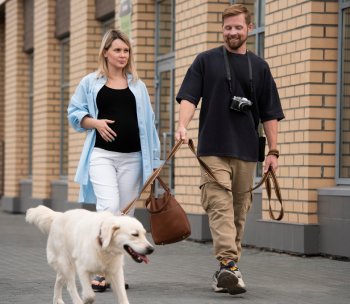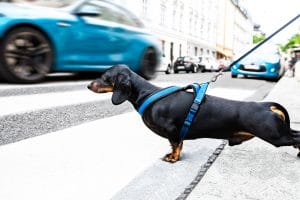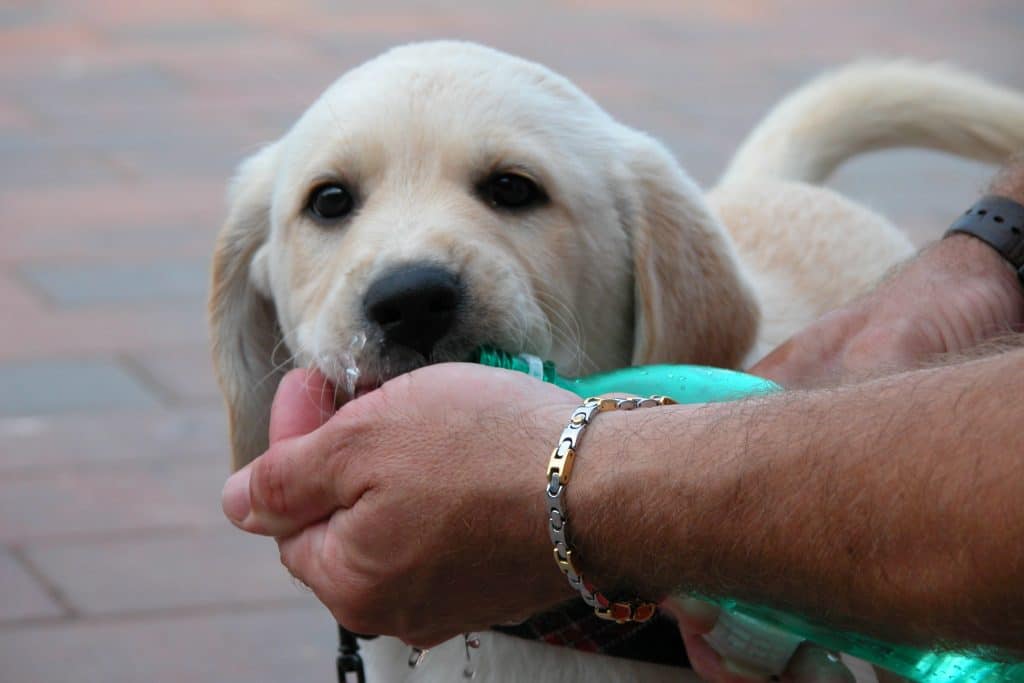![]()
HeelBoyHeel is reader supported. When you buy through any link on our site, we may earn an affiliate commission, but never at any extra cost to you.
The walk is one of the highlights of your dog’s day. Below are some tips to ensure that you and your dog can enjoy your walk safely. If you are aware of potential dangers, you can take precautions to avoid them.

1. Physical Fitness
Physical fitness applies to both you and your dog, especially if you are planning to attempt a longer or more strenuous walk than usual.
Make sure that you feel confident of your own physical fitness. If you have any underlying health issues or doubts in your ability, check with a health official before heading out.
If you have a young puppy or an older dog, be aware that a longer or more strenuous walk than he or she is used to may cause joint pain. Your vet will be able to advise you if you have any worries about this.
2. Make Sure You Stay Hydrated
Both you and your dog may need clean water on your walk, especially in hot weather, to help avoid the risk of heatstroke. So, don’t forget the water bottle! Some dogs are able to drink water from a bottle. If your dog finds this difficult, take a small bowl. It is possible to buy dog bowls which are light to carry and can be laid flat when not in use.
If you have forgotten to take water with you, make sure you do not let your dog drink standing water!
3. Use The Correct Equipment
Once again, this applies to both you and your dog.
Make sure you are wearing the appropriate, comfortable footwear, in order to enjoy the walk. Blisters are no fun! Depending on the weather, you may need a hat to keep the sun off your head or a waterproof coat for rain showers. If you have a mobile phone, be sure to take it with you. If not, let somebody know where you are going and how long you will be.
Now your dog! The dog leash needs to be strong and comfortable for you to hold. It does not need to be too long, it is easier to control a dog on a medium length leash. A retractable leash is not a good idea unless you have a very well trained dog and you are in an open area.
Your dog will already have a collar but a dog harness will be much more comfortable for him or her on a walk. A harness also gives you more control without hurting your dog. If you plan to walk your dog at night, it’s a good idea get a reflective harness. Ensure that the harness fits correctly. Your dog can still wear the collar with the harness so that he or she can be easily identified, if necessary. It is recommended that you also have your dog microchipped in case he or she slips the lead.
Don’t forget to take something so that you can pick up any “poo” your dog is responsible for.
4. Intestinal Parasites!
This covers about four or five different kinds of internal worms that your dog can develop. Not a nice thought!
There are a few ways that your dog can develop worms when out for a walk. To prevent this, avoid him or her drinking standing, warm water, eating things he or she finds on the walk and investigating “poo”! This is why it is especially important to clean up after you dog.
Your dog should also be wormed regularly to also prevent intestinal parasites with medication from your vet or pharmacy.
5. Traffic

When you are walking where there are vehicles, it is particularly important to have complete control over your dog. This is where the amount of dog training you have achieved will pay off and your full attention is needed. Many dogs are involved in traffic accidents every year and they can also cause accidents when drivers try to avoid them.
Keep your dog close to you on a short leash. When crossing roads with traffic, make sure your dog sits and waits until you are ready to cross the road. On country roads without pavements, walk on the side of the road facing oncoming traffic. Your dog should be on your left hand side, furthest away from the traffic.
6. Avoid Dogs Not On A Leash
Your dog may be friendly towards other dogs, however, this is not the case with all dogs. If you meet another dog on a leash, the dogs will probably want to give each other a good “hello” sniff. If the dogs don’t see “eye to eye” it is relatively easy for you and the other owner to separate them before they go “tooth to tooth”.
However, if you see a dog who is not on a leash it is best to avoid it, if possible. Your dog is at a disadvantage with being on a leash and for some reason, the dog without a leash knows this!
7. Watch Your Dog’s Behaviour When Meeting Dogs While Walking

If you have a dog who is not confident around other dogs, this may result in aggressive behaviour. You need to watch your dog for tell tale signs that there may be a problem when he or she meets another dog. The signs are usually obvious, hackles up, lips pulled back to bare teeth, etc. So, make sure that your dog is not put in a situation where this happens.
If your dog is normally confident with other dogs, watch for other signs that there may signal a problem. The “waggy” tail may drop and he or she may try to get away from the newcomer. Help your dog by walking steadily away. If the newcomer does not have a leash it may follow you both for a while, until something more interesting catches it’s eye.
8. Altercations With Other Dogs
Although uncommon, sometimes a meeting between your dog and another will develop into a fight. It is important that you remain calm, please don’t try to kick or hit the other dog as this will only escalate the problem. You can try throwing water over the dogs or making a loud noise to distract them. If the other dog owner is there, you can both grab your own dog’s back legs and pull them apart. Keep hold of the dogs until they are a safe distance apart.
Usually a dog fight will be over after a few seconds, though it will feel a lot longer! Try to stay calm and only intervene if you feel confident to do so.
Once you are well away from the incident and the other dog, take your dog to be checked out by your vet. Even if you are unable to see any signs of injury on your dog, it is important to make sure that he or she has not sustained an injury. If you have been bitten in the altercation, see your health care official as dog bites can easily be infected.
9. Keep Your Dog Away From Garbage
There will be few things more interesting to your dog than discarded garbage! The dog has smell as his primary sense, so smelly garbage is great. However, as well as the “interesting” smell, it can result in garbage toxicosis or garbage gut.
Garbage gut is the result of your dog eating spoiled food, so basically food poisoning or bacterial disease. The result of garbage gut for your dog may be diarrhoea, fever and/or vomiting, or worse.
If you think your dog has eaten something on your walk resulting in garbage gut, it is best to see your vet. The vet will be able treat your dog’s food poisoning.
10. Watch Out For Pesticides And Rodenticides
As a dog owner, you will be well aware to check before using pesticides and rodenticides in an area your dog has access to. As well as his or her nose, your dog will use his or her mouth for exploration!
However, when you are out for your walk, you will not know what has been put on other peoples lawns and gardens. So, these are definitely off limit for your dog. Also, be aware that a rodent or wild animal that has eaten a rodenticide and died is also poisonous.
The effects on your dog from these poisons can vary from vomiting to seizures and everything in between. It is extremely important that you take your dog to see a vet immediately.
Conclusion
The above points are there to help you be aware, not to put you off going for a walk with your dog. As the responsible adult, you are there to take care of your dog! Hopefully, this will help to make your dog walking a little safer and consequently, more enjoyable!
